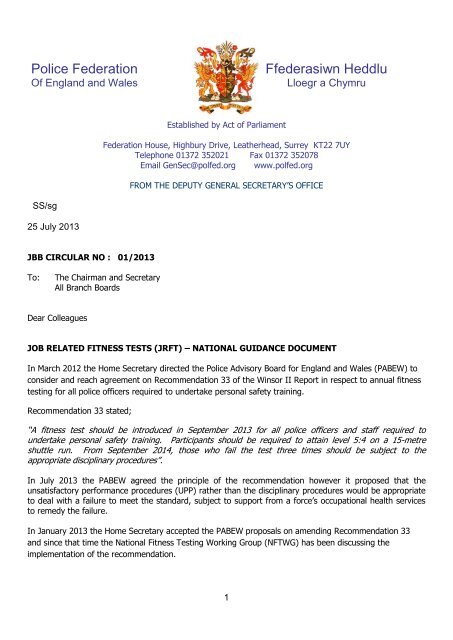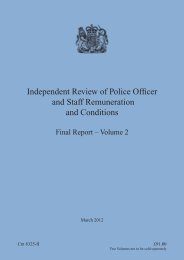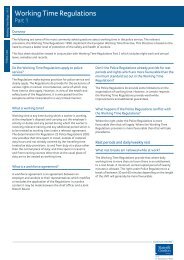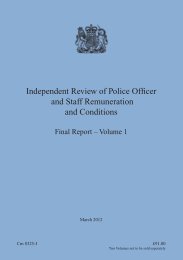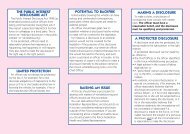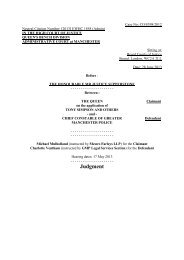Fitness Testing - the South Wales Police Federation
Fitness Testing - the South Wales Police Federation
Fitness Testing - the South Wales Police Federation
Create successful ePaper yourself
Turn your PDF publications into a flip-book with our unique Google optimized e-Paper software.
POLICE ADVISORY BOARD FOR ENGLAND & WALESJob Related <strong>Fitness</strong> Tests for <strong>the</strong> <strong>Police</strong> Service of England and <strong>Wales</strong>Winsor Recommendation 33Implementation – Interim GuidanceJuly 2013ContentsPage1. Introduction 22. <strong>Police</strong> Staff testing 23. Health and Safety Compliance 24. JRFT Standards 25. Equality and Diversity 46. Delivery 57. Data Collection 5Tables1. Specialist Post JRFT Endurance and Strength Standards 3Appendices1. Home Office Circular 43/2004 62. JRFT Risk Assessment 73. Equality Impact Assessment 124. Occupational Health Screening Questionnaire 165. Health Declaration 17POTENTIAL FOR LEGAL CHALLENGEThis Guidance has been produced by <strong>the</strong> PABEW <strong>Fitness</strong> Working Group to support <strong>the</strong>assessment and validation process of <strong>the</strong> introduction of <strong>the</strong> Job Related <strong>Fitness</strong> Test for servingpolice officers. <strong>Police</strong> Forces that implement <strong>the</strong>se standards will be able to cite <strong>the</strong>m as beingassessed as reasonable and appropriate under <strong>the</strong> Equality Act and <strong>the</strong> Health and Safety atWork Act. Any derogation from <strong>the</strong>se standards carries a risk of legal challenge from an officerdisadvantaged by <strong>the</strong> implementation of a higher or a lower standard, any additional standards ora different method of assessment than those recommended in this Guidance.3
1. IntroductionThe Home Secretary accepted <strong>the</strong> recommendation of <strong>the</strong> <strong>Police</strong> Advisory Board of England and<strong>Wales</strong> (PABEW) to introduce, in part, <strong>the</strong> recommendation made in Winsor (Part II) for annualfitness testing of serving police officers.The initial recommendation (33) to implement fitness testing made by <strong>the</strong> Winsor Review (Part II)report was that “A fitness test should be introduced in September 2013 for all police officers andstaff required to undertake personal safety training. Participants should be required to attain level5:4 on a 15-metre shuttle run. From September 2014, those who fail <strong>the</strong> test three times shouldbe subject to <strong>the</strong> appropriate disciplinary procedures”.The PABEW re-considered <strong>the</strong> part of <strong>the</strong> recommendation that officers who fail <strong>the</strong> test on threeoccasions should be subject to appropriate discipline procedures. They recommended instead thatsupportive action should be provided by Forces to officers who fail <strong>the</strong> test through <strong>the</strong> Forceperformance procedures.It should be noted that whilst <strong>the</strong> Winsor Review made o<strong>the</strong>r recommendations linked to in-servicefitness testing, <strong>the</strong>se are still <strong>the</strong> subject of on-going negotiations.The Home Secretary accepted <strong>the</strong> Winsor recommendation 33 subject to <strong>the</strong>se caveats proposedby <strong>the</strong> PABEW. The PABEW tasked <strong>the</strong> National <strong>Fitness</strong> Working Group with <strong>the</strong> development ofguidance for Forces in <strong>the</strong> implementation of annual fitness testing in <strong>the</strong> short term, and <strong>the</strong>assessment of <strong>the</strong> likely impact of <strong>the</strong> tests in <strong>the</strong> longer term.This guidance sets out how Forces should implement <strong>the</strong> new arrangements and enable <strong>the</strong><strong>Fitness</strong> Working Group to make longer term recommendations to ensure that <strong>the</strong> fitness tests donot unlawfully discriminate against officers because of <strong>the</strong>ir disability, gender or age. The Groupswork seeks also to reduce <strong>the</strong> risk of a legislative breach of <strong>the</strong> law relating to health and safetyand subsequent challenge because of injury or illness suffered by an officer; and allows <strong>the</strong>maximisation of resources available to deliver operational policing.It is important that appropriate interpretation is made to this template to reflect <strong>the</strong> differingmanagement and organisational structures throughout <strong>Police</strong> Services in England and <strong>Wales</strong>.2. <strong>Fitness</strong> <strong>Testing</strong> - <strong>Police</strong> StaffNo decision has been made with respect to fitness testing for <strong>Police</strong> Staff; Winsorrecommendation 33 as relates to <strong>the</strong>se employees remains outstanding. It is anticipated that <strong>the</strong>PAB <strong>Fitness</strong> <strong>Testing</strong> Working Group will now address this.3. Health and Safety ComplianceThe information within this document will assist <strong>Police</strong> Services with compliance of <strong>the</strong> JobRelated <strong>Fitness</strong> Test standards to <strong>the</strong> Health and Safety at Work Act (HSWA) 1974 and <strong>the</strong> <strong>Police</strong>(Health and Safety) Act 1997. This document complies with <strong>the</strong> Health and Safety Executive(HSE) guidance on <strong>the</strong> effective management of health and safety in <strong>the</strong> workplace - HSG65.4. Job Related <strong>Fitness</strong> Test (JRFT) StandardsTable 1: Recommended Winsor Recommendation (33) Job Related <strong>Fitness</strong> Test Standard:4
The Job Related <strong>Fitness</strong> Test is purely one measuring endurance and is based on scientificresearch to match <strong>the</strong> physical demands of officer safety training. It is this basis that gives <strong>the</strong> testlegitimacy and on which we can justify its relevance. The standard of <strong>the</strong> JRFT is <strong>the</strong> same as <strong>the</strong>standard for recruitment of officers.CandidateRecommended Endurance Standard(Level : Shuttle)<strong>Police</strong> Officer 5 : 4*Note – <strong>the</strong> upper body strength test is not included within <strong>the</strong>se standards4.1 In-service JRFT – IntroductionIn order to facilitate <strong>the</strong> implementation of <strong>the</strong> JRFT for in-service fitness testing, <strong>the</strong> PABEW hasaccepted that in <strong>the</strong> first year (from September 2013 to September 2014) <strong>the</strong>re should be nosanction applied to those officers who fail <strong>the</strong> fitness test or for those who are unable totake it because of a medical reason. The reason provided should be assessed by <strong>the</strong> ForceOccupational Health provider.It is important that <strong>the</strong>re is diversity monitoring in Force of those officers who pass, fail or areunable to take <strong>the</strong> test, and that this is provided to <strong>the</strong> <strong>Fitness</strong> Working Group for a nationalassessment of adverse impact. This will also enable <strong>the</strong> <strong>Fitness</strong> Working Group to assess <strong>the</strong>future requirements, including to establish whe<strong>the</strong>r an appropriate alternative test should bedeveloped, in line with Winsor’s recommendation.Some forces have already implemented alternative tests and it is important to highlight that thisapproach may face certain risks. The 5.4 shuttle run testing can be justified as equivalent to <strong>the</strong>levels of aerobic activity reached in Personal Safety Training (defined in terms of VO 2 maxuptake). The risk with an alternative is that it may not be adequately validated against nationalstandards and could have an adverse impact on officers from some of <strong>the</strong> protected groups whichForces may not be able to justify if challenged. The National <strong>Fitness</strong> <strong>Testing</strong> Working Group hascommenced work to establish <strong>the</strong> need for an alternative test and if one is required, what that testshould be. Forces will be updated once <strong>the</strong> <strong>Fitness</strong> <strong>Testing</strong> Working Group has finalisedconsultation on a validated alternative.4.2 JRFT Standards – Application NoteThe <strong>Fitness</strong> Working Group proposes that this pass standard is implemented as a pre-selectionprocess for <strong>Police</strong> Officers undertaking Officer Safety Training and is subject to a retesting regimeonce a year. All officers tested should wear appropriate physical training clothing and footwear,not operational police uniform and/or equipment.It is advised that <strong>the</strong> testing is undertaken in an indoor facility with suitable flooring and floormarkings. It is important to ensure that <strong>the</strong> recording of <strong>the</strong> 15 metre multi-stage fitness test canbe heard clearly from all parts of <strong>the</strong> facility where <strong>the</strong> testing is being undertaken. The suitabilityof <strong>the</strong> facility must be addressed within <strong>the</strong> risk assessment.The National <strong>Fitness</strong> <strong>Testing</strong> Working Group recognises that some forces have moved away fromannual officer safety training and in <strong>the</strong>se forces <strong>the</strong> force should consider how <strong>the</strong> objectivebehind this policy can best be achieved.4.3 JRFT Familiarisation5
It is important that Forces complete <strong>the</strong> monitoring form accompanying this guidance so that <strong>the</strong><strong>Fitness</strong> Working Group can complete a proper evaluation of equality impact at regular intervalsduring <strong>the</strong> first year of implementation. The <strong>Fitness</strong> Working Group will make recommendations asto whe<strong>the</strong>r <strong>the</strong> process needs to be amended based on <strong>the</strong> outcome of <strong>the</strong> full equality impactassessment.6. DeliveryIt is accepted that <strong>the</strong> training structure and facilities within each <strong>Police</strong> Service will dictate how atesting regime is delivered and at what cost.6.1 Health and SafetyA specific risk assessment for <strong>the</strong> Job Related <strong>Fitness</strong> Test must be completed in line with <strong>the</strong>Health and Safety Executive’s ‘5 step risk assessment’ template by a suitably experienced person.It is advised that <strong>the</strong> risk assessment is reviewed by a designated Health and SafetyAdviser/Officer periodically or in <strong>the</strong> eventuality of significant injury/illness to a participant or if anorganisational re-structure effects JRFT delivery. An example (only) of an appropriate riskassessment is shown at appendix 2; o<strong>the</strong>r consideration to your own <strong>Police</strong> Service may beneeded to add or influence <strong>the</strong> scoring or content of such a risk assessment.6.2 StaffingForces must be satisfied that staff members delivering <strong>the</strong> JRFT test are competent to do so andmust be First Aid certified; <strong>the</strong> qualification/certification must be recorded within <strong>the</strong> riskassessment.6.3 Medical ScreeningAll candidates should complete a medical screening questionnaire prior to undertaking <strong>the</strong> JRFT(an example screening questionnaire is attached at appendix 4). The screening questionnairemust be part of <strong>the</strong> risk assessment and approved by an Occupational Health specialist. It isadvised that <strong>the</strong> medical screening questionnaire is reviewed by a designated Occupational HealthSpecialist periodically or in <strong>the</strong> eventuality of significant injury/illness to a participant. It issuggested <strong>the</strong> Occupational Health sanctioned screening questionnaire is completed as part of <strong>the</strong>pre-join instructions, which will identify <strong>the</strong> requirement for a referral to a specialist for fur<strong>the</strong>rassessment and determination of suitability for <strong>the</strong> individual to participate in <strong>the</strong> JRFT. On <strong>the</strong> dayof <strong>the</strong> test, it is advised a fur<strong>the</strong>r ‘Health Declaration’ (appendix 5) should be completed byparticipants confirming that <strong>the</strong>re has been no change in <strong>the</strong>ir personal circumstance in anyintervening period. This process is already in place in many forces with regard to Officer SafetyTraining.7. Data CollectionIt is important at this early stage to audit <strong>the</strong> numbers of passes and failures and understand howspecific groups of individuals (i.e. age and gender) are performing. Each force is required tocollect results from <strong>the</strong>ir testing regime on <strong>the</strong> data collection excel document provided by <strong>the</strong>Home Office. The Home Office will request <strong>the</strong> results on a date to be notified..7
APPENDIX1Home Office Circular 43/2004 (relevant section)Test elements and standardsThe test administrator must ensure that all candidates are sufficiently warmed up for <strong>the</strong> test. Thisshould involve some whole body activity such as jogging followed by appropriate stretchingexercises, particularly of <strong>the</strong> leg muscles. It would be useful to familiarise candidates with <strong>the</strong> testby taking <strong>the</strong>m to level 3 as part of <strong>the</strong> warm up followed by basic mobility stretching activities.Page 2, Paragraph 48
*Persons atriskSeverity ofHazardLikelihoodof RiskAPPENDIX2JRFT (5:4) - RISK ASSESSMENTRisk to <strong>the</strong> participants undertaking JRFTActivity/Task Assessed: Name of Assessor: Assessment No: Type of assessmentSpecificDate Implemented: Date of last assessment: Review date:NoActivity/WorkplaceHazardsOverallRiskLevelH,M,LControl Measures/CommentsRevisedRiskLevelFur<strong>the</strong>ractionrequired?(Y/N)1 Pre-JRFT(Screeningand pretest)a. Seriousillness orfatalityP, PS 5 2 10 (M) Implement PositiveAction/Familiarisation oftesting regime throughoutall potential participants. Informed consent andhealth screeningquestionnaire to becompleted prior to <strong>the</strong>JRFT. Questionnaire to bereviewed by appropriateperson. DO NOT TEST any staffidentifying medicalproblems on <strong>the</strong>questionnaire. Occupational Healthreferral for any potentialproblems identified within<strong>the</strong> questionnaire.*Persons at risk include participant (P), Instructor (I), <strong>Police</strong> Service (PS)5 (L)9
Risk Estimator MatrixSeverityLikelihoodNo InjuryFirst AidInjuryLost Time(Over 3 Days)Major Injury orDisablingDiseaseImprobable 1 2 3 4 5DeathRemote 2 4 6 8 10Possible 3 6 9 12 15Probable 4 8 12 16 20Very likely tooccur5 10 15 20 25WARNING – HEALTH & SAFETYIt is advised that all officers undertaking <strong>the</strong> standards are not run beyond <strong>the</strong> endurancepass standards outlined in Table 1 (page 2).13
Equality Impact AssessmentAPPENDIX 3Title of policy: Initial implementation of in-service fitness tests2013Date: 7 June1: Identify <strong>the</strong> aims and purpose of <strong>the</strong> policyThis should identify “<strong>the</strong> legitimate aim” of <strong>the</strong> policy (<strong>the</strong>re may be more than one)To ensure that fitness testing for serving police officers are carried out consistentlyacross forces and are non-discriminatory.2: Identify <strong>the</strong> individuals and organisations likely to have an interest in, or beaffected by <strong>the</strong> policy.This should identify <strong>the</strong> persons/organisations who may need to be consulted about<strong>the</strong> policy or procedure and its outcomes (There may be more than one)On 2003 <strong>the</strong> <strong>Police</strong> Advisory Board of England and <strong>Wales</strong> (PABEW) expressedconcerns about <strong>the</strong> potential for unlawful discrimination in t certain fitness standardsoperated by Forces. They commissioned a <strong>Fitness</strong> Working Group to makerecommendations for:1. an interim solution as to <strong>the</strong> type and level of fitness required at recruitmenton <strong>the</strong> best evidence currently available, based on an assessment of job andcompetency requirements;2. how <strong>the</strong> recruitment fitness test (based on <strong>the</strong> interim solution at bullet point 1above) should be conducted fairly and consistently and what <strong>the</strong> responseshould be to those who do not meet <strong>the</strong> standard;3. fur<strong>the</strong>r work (with timetable to progress) that will be needed to (a) assess fully,and validate, <strong>the</strong> required standards and test, (b) establish <strong>the</strong> type and levelof job- and competence-related fitness required for specialist roles and how totest fairly and effectively for <strong>the</strong>m, and (c) establish <strong>the</strong> possible needs for,and forms of, on-going support and assessment of <strong>the</strong> fitness and health ofpolice officers.The PABEW commissioned a <strong>Fitness</strong> Working Group to develop guidance in thisarea. By 2011 <strong>the</strong> <strong>Fitness</strong> Working Group had completed work identified at items 1,2, 3(a) and 3(b).In 2012 <strong>the</strong> Winsor Review of <strong>Police</strong> Officer and staff remuneration and conditionsrecommended:a fitness test should be introduced in September 2013 for all police officersand staff required to undertaken personal safety training. Participants shouldbe required to attain level 5:4 on a 15-metre shuttle run.This recommendation was accepted in part by <strong>the</strong> PABEW who agreed that anannual fitness test of 5.4 on a 15 metre shuttle run should be introduced for servingRepresent · Influence · Negotiate
officers who are required to undertake officer safety training (OST). Theirrecommendation was accepted by <strong>the</strong> Home Secretary. The PABEW commissioned<strong>the</strong> <strong>Fitness</strong> Working Group to develop this proposal for implementation.3. ConsultationWho was consulted and how? (This should include reference to people andorganisations identified in section 2 above)The Working Group was made up of representatives of <strong>the</strong> organisations on PABEWwhose members would be interested in and affected by <strong>the</strong> policy.The Working Group commissioned an external agency, Lilleshall ConsultancyServices, to develop appropriate fitness standards and to validate those standards.4: ResearchSummarise <strong>the</strong> findings of any research you have considered regarding this policy.This could include quantitative data and qualitative information; anything you haveobtained from o<strong>the</strong>r sourcesLilleshall Consultancy Services developed <strong>the</strong> Job Related <strong>Fitness</strong> Test (JRFT) forrecruits to <strong>the</strong> <strong>Police</strong> Service in 2004. A comprehensive review of <strong>the</strong> literaturerelating to functional fitness tests in working environments was undertaken as part ofthat project. By measuring <strong>the</strong> “real time” physiological demands of Officer SafetyTraining (OST) Lilleshall Consultancy Services recommended that level 5.4 on a 15metre shuttle run was an appropriate level to replicate <strong>the</strong> demands of OST.Operational officers are required to undertake OST on a regular basis.The Working Group reviewed <strong>the</strong> equality legislation and case law in this area. Theyidentified that <strong>the</strong>re was <strong>the</strong> potential for unlawful sex and age discrimination tooccur in <strong>the</strong> application of in-service fitness testing.A test that is part of a selection process for a job comes under <strong>the</strong> requirements of<strong>the</strong> employment provisions of <strong>the</strong> equality legislation. A fitness test has <strong>the</strong> potentialto discriminate unlawfully both directly and indirectly. Direct discrimination occurs ifsomeone is treated less favourably because of a protected characteristic. Indirectdiscrimination occurs if a provision criterion or practice (in this case, <strong>the</strong> fitness test)puts someone from a protected group at a disadvantage, and which is unable to bejustified as being a proportionate means of achieving a legitimate aim.1. Sex DiscriminationA lower pass mark for women than for men would result in unlawful directdiscrimination against men who are denied a job if <strong>the</strong>y passed <strong>the</strong> women’s passmark, but not <strong>the</strong> man’s; see Allcock v Hampshire Constabulary. Direct sexdiscrimination cannot be justified in law. A fitness test which has <strong>the</strong> same pass markfor men and women but which fewer women than men are able to pass, couldindirectly discriminate against women if it does not accurately reflect <strong>the</strong>requirements of <strong>the</strong> role; see Dougan v RUC and Bamber v GMP.2. Age DiscriminationA lower pass mark for older people would result in direct discrimination againstyounger people denied a job if <strong>the</strong>y passed <strong>the</strong> older person’s pass mark, but not <strong>the</strong>Represent · Influence · Negotiate
one for younger people. Unlike direct sex discrimination, direct age discriminationmay be justified in law. A higher standard for younger people would <strong>the</strong>refore have tobe justified if it is a proportionate means of achieving a legitimate aim.A fitness test which has <strong>the</strong> same pass mark for all age groups but which fewer olderpeople can pass, could indirectly discriminate against older people if it does notaccurately reflect <strong>the</strong> requirements of <strong>the</strong> role; see Bamber v GMP.3. Disability DiscriminationThe Equality Act requires that reasonable adjustments are made for disabled peoplein employment if a provision, criterion or practice (such as a fitness test) puts <strong>the</strong>m ata substantial disadvantage when compared to non-disabled people.The Winsor Review policy equality statement recognised that “Forces should takecare to treat appropriately those who are assessed as unable to pass <strong>the</strong> testbecause of a health condition or problem. It could be as a result of a disability under<strong>the</strong> Equality Act 2010”. The Review postulated that “officers and staff with a hearingimpairment, or ano<strong>the</strong>r medical reason which would prevent <strong>the</strong>m from running <strong>the</strong>shuttle run test, would need to have an appropriate alternative provided ... Thosewho are unable to take <strong>the</strong> test for reasons of illness, injury or disability would alsobe referred to occupational health departments for advice and assistance or fur<strong>the</strong>raction”.5. MonitoringSummarise <strong>the</strong> findings of any monitoring data you have considered regarding thispolicy. This could include data which shows whe<strong>the</strong>r <strong>the</strong> policy is having <strong>the</strong> desiredoutcomes and also its impact on members of different equality groups.The Working Group was mindful of <strong>the</strong> data presented in <strong>the</strong> Winsor Review fromHampshire Constabulary where an in-service fitness test had been operatedbetween June 2010 and July 2011. This showed disproportionate impact on <strong>the</strong>grounds of age and sex. Whilst 20% of eligible officers did not attend <strong>the</strong> test, 97% ofthose who took <strong>the</strong> test passed. However 0.6% of male officers failed <strong>the</strong> testcompared with 5.3% of females. The average age of females who failed <strong>the</strong> test was42, whilst <strong>the</strong>ir average age overall was 35. The average age of males who failed <strong>the</strong>test was 47, whilst <strong>the</strong>ir average age was 38 years.The Working Group were also mindful of <strong>the</strong> disproportionate impact because of sexand age identified in <strong>the</strong> validation of <strong>the</strong> JRFT for recruits and for specialist posts;see relevant EIAs6. ConclusionsTaking into account <strong>the</strong> results of <strong>the</strong> monitoring, research and consultation, set outhow <strong>the</strong> policy impacts or could impact on people from <strong>the</strong> following protectedgroups? (Include positive and/or negative impacts)Represent · Influence · Negotiate
6.1 AgeThere is likely to be an adverse impact on older officers.6.2 DisabilityThere is likely to be adverse impact on officers with certain disabilities.6.3 GenderThere is likely to be adverse impact on women officers.No adverse impact is anticipated because of gender re-assignment.6.4 RaceNo difference in impact is anticipated.6.5 Religion or BeliefNo difference in impact anticipated6.6 Sexual OrientationNo difference in impact anticipated7. DecisionsIf <strong>the</strong> policy will have a negative impact on members of one or more of <strong>the</strong> protectedgroups, explain how <strong>the</strong> policy will change or why it is to continue in <strong>the</strong> same way.If no changes are proposed, <strong>the</strong> policy needs to be objectively justified as being anappropriate and necessary means of achieving <strong>the</strong> legitimate aim set out in 1above___________________________________________________________________The <strong>Fitness</strong> Working Group has proposed that <strong>the</strong> first year of implementation ismonitored for disproportionate impact because of age, sex and disability. The resultswill be analysed by <strong>the</strong> <strong>Fitness</strong> Working Group and, if necessary and if appropriate,changes will be proposed to <strong>the</strong> College of Policing that reduce or remove anyunjustifiable adverse impact.Represent · Influence · Negotiate
JOB RELATED FITNESS TEST (JRFT) - MEDICAL QUESTIONNAIREAPPENDIX 4Name ……………………………………………………………………………Date ………………………………………Work Location …………………. Contact telephone No: …………………….... Warrant/Pay………………………………The purpose of this questionnaire is to ensure that your health is not placed at risk when you perform <strong>the</strong> JRFT. Thequestionnaire is intended to screen for pregnancy and cardiovascular disease risk factors.If no positive answers are given to any questions from 1 to 8 you may take <strong>the</strong> JRFT. Please pass your completedquestionnaire to <strong>the</strong> PT staff administering <strong>the</strong> JRFT. If a positive answer is given to question 1 you cannot take <strong>the</strong> JRFT.If a positive answer is given to question 2 your blood pressure will have to be measured within three days of your JRFT andif <strong>the</strong> reading is high (systolic >160 and/or diastolic >100) you will not be able to take <strong>the</strong> JRFT. Your BP can be measuredby your GP or a qualified nurse. A date, signature and name must be provided in <strong>the</strong> appropriate area. Your BP can also bemeasured on <strong>the</strong> day of <strong>the</strong> test by one of <strong>the</strong> PT staff. Please contact <strong>the</strong> PT staff prior to your JRFT if you anticipate youwill need a BP test on <strong>the</strong> day of your JRFT.If a positive answer is given to any questions from 3 to 8, again you will not be able to take <strong>the</strong> JRFT.If a positive answer is given to any of questions 3 to 7, go to question 8. Answer NO, if you personally or a close relativehave had no diabetic or cardiac event in <strong>the</strong> past 12 months, and you have taken <strong>the</strong> JRFT within <strong>the</strong> same period. If a NOis given to Q8 you CAN take <strong>the</strong> JRFT.If a positive answer is given to questions 3 to 8 on <strong>the</strong> day of your JRFT, or if prior to attending your JRFT, you feel apositive answer will be given to a question, which may prevent you taking <strong>the</strong> test, please contact <strong>the</strong> PT staff.Please tick Yes No1. Are you pregnant or have you given birth within 7 months of today’s date?2. Are you currently taking medication for high blood pressure?Blood Pressure Measurement Recorded…… / ……Date;…………………… Sig;……………………………………. Name;………………………………..3. Do you suffer from diabetes?4. To <strong>the</strong> best of your knowledge have you ever suffered fromany of <strong>the</strong> conditions listed below?Heart attack or heart disease?Cardiomyopathy (enlargement of <strong>the</strong> heart)?Myocarditis or pericarditis (inflammation of <strong>the</strong> heart)?A heart murmur or heart valve problem?5. Have you ever attended your GP or a specialist complainingof chest pain?6. Are you currently having investigations or treatment for aheart problem?7. Has any close relative e.g. fa<strong>the</strong>r, mo<strong>the</strong>r, bro<strong>the</strong>r or sisterhad a heart attack at a young age (e.g. between 35 and 60)?Complete Q8 if you have previously given a ‘Yes’ to any of Questions 3 to 7 and taken <strong>the</strong> JRFTwithin <strong>the</strong> last 12 months. If you answer NO to question 8 you can take <strong>the</strong> JRFT.8. In <strong>the</strong> past 12 months have you experienced a diabetic or cardiac eventand or has a close relative experienced a cardiac related incident?Signature …………………………………………………………………………………………………………Represent · Influence · Negotiate
Health DeclarationJRFT HEALTH DECLARATION.APPENDIX 5I am at present undergoing treatment / taking medication under <strong>the</strong> direction of amedical practitioner (including physio<strong>the</strong>rapy). I have <strong>the</strong> following injury / condition.(Enter details in comment box below or strike through as appropriate).Comments:I understand that failure to disclose any existing medical or physiological conditionmay affect any future claim for loss or injury as a result of this training or undertaking<strong>the</strong> Job Related <strong>Fitness</strong>Test.Date: ...............................................................................Signed: ............................................................................Print Name: .....................................................................Warrant / Employee No.: ................................................Trainers Comments (confirm with individual if <strong>the</strong>y have undertaken a OH assessmentconcerning <strong>the</strong>ir suitability to undertake JRFT, and if any of <strong>the</strong> conditions have arisensubsequent to that assessment):This form may be forwarded to Occupational Health if requiredRepresent · Influence · Negotiate


